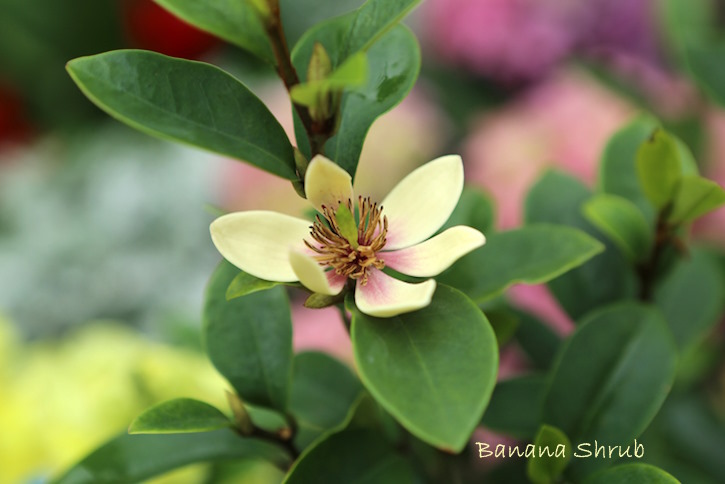Banana Shrub Care – Michelia figo aka Magnolia figo
Botanical Name: Michelia figo or Magnolia figo
Banana Shrub is a sub-tropical evergreen that makes a gorgeous container plant. Its creamy yellow flowers, sometimes with a blush of purple, are small and cupshaped, resembling mini magnolia blossoms. However, what makes the blooms especially captivating is their sweet banana-like fragrance.

Buy Banana Shrub
Michelia figo is also known as Magnolia figo because it is in the magnolia family, and may labeled by that name. You may have difficulty finding this fragrant shrub in garden centers unless you live in a tropical or subtropial climate. Look for it at online nurseries.
Give your plant plenty of sunlight and you can expect a show of fragrant flowers in early spring, with blooms continuing sporadically through the summer.
Even before it blooms, its glossy, dark-green foliage is attractive. If you notice new leaves covered with brown fuzz, that’s normal until they mature, growing to about 3-in (8 cm) long. Michelia figo banana shrub is evergreen and makes a beautiful indoor tree year-round.
Did you buy a small nursery plant? It may look sparse, with few branches and leaves. Give it time. Your banana shrub will soon grow lush and full. And Michelia figo is eager to bloom, so you won’t have to wait long for the wonderfully scented flowers.
Wondering when to repot? Pot up only when the plant fills the container, moving to a pot that’s only 1-2 inches larger. Why? Using a pot that’s too big will hold too much water, which can lead to root rot. Besides, your banana shrub blooms best when its roots are slightly root-bound.
Brown leaf tips indicate dry soil or a build up of soluble salts. Soluble salts come from the chemicals in tap water and fertilizers and can damage foliage and roots. It’s a good idea to flush salts from the soil every year.
How to Flush Salts: Slowly pour lukewarm water over the soil. Allow water to drain out the drainage holes. Pour more water through the pot, then empty the drainage tray. Flushing salts every year will keep your plant healthier and takes only minutes to do.
Prune it back. Unlike many shrubs, this one is slow-growing, with a round, compact shape. It will grow tall unless you prune it back. Winter is the best time to prune. Cut just above a node. Cuts made here will encourage branching. Always use sharp pruners to avoid tearing the stems.
Banana Shrub Care
Origin: China
Height: Up to 6 to 10 ft (1.8 to 3 m); it responds well to pruning and can be easily kept around 4-5 ft (1-1.5 m)
Light: Bright light to direct sun.
Water: Small plants should be kept lightly moist. This shrub is drought-tolerant when it is grown. For larger plants, drench and dry: water thoroughly to moisten all the roots, then allow the top 1-2 inches to dry out before watering again. Use a pot with drainage holes — soggy potting medium can lead to root rot.
Humidity: Aim to maintain 50% relative humidity or higher. You can increase humidity around the plant by putting it on pebble tray. The pebbles keep the pot above the water so the roots don’t rot. I do this for some of my plants and it works beautifully to add humidity to the air around them.
Temperature: Average room temperatures 65-75°F/18-24°C. This subtropical shrub is hardy to USDA Zone 8, so if you scoot the container outdoors for the warm months, bring it back in when the temp drops in autumn.
Soil: Slightly acidic medium that drains well, a peat moss-based potting mix such as African violet mix is ideal.
Fertilizer: Feed every 2-3 weeks with a high-phosphorous fertilizer, while plant is growing (spring and summer). I usually use half the recommended amount of fertilizer on the container.
Propagation: Take 4 in (10 cm) stem tip cuttings (with leaves attached) in summer. Dip the cut ends in rooting hormone powder, then insert in sterile moist potting medium. They’ll root easily in about 5-6 weeks.
Take a Stand
Running out of space for your house plants? Indoor plant stands may be just the solution. Take a look at these new ways to display your indoor plants.




